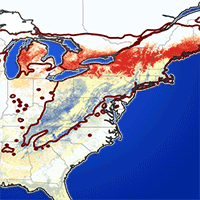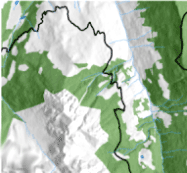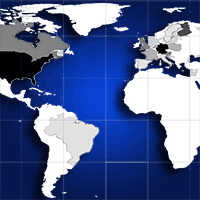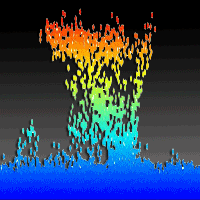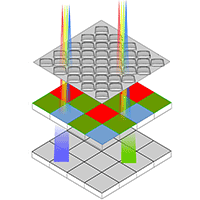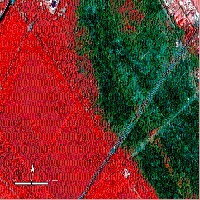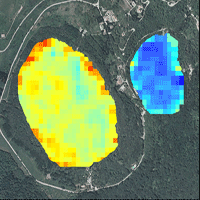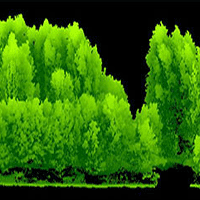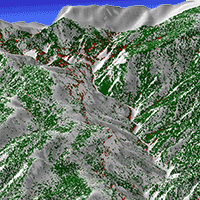
Development of monitoring methods for Hemlock Woolly Adelgid induced tree mortality within a Southern Appalachian landscape with inhibited access
Tuula Kantola (1) , Päivi Lyytikäinen-Saarenmaa (2), Robert N Coulson (1), Markus Holopainen (2), Maria D Tchakerian (1), Douglas A Streett (3)
iForest - Biogeosciences and Forestry, Volume 9, Issue 2, Pages 178-186 (2016)
doi: https://doi.org/10.3832/ifor1712-008
Published: Jan 02, 2016 - Copyright © 2016 SISEF
Research Articles
Abstract
Hemlock woolly adelgid (Adelges tsugae Annand, HWA) is an introduced invasive forest pest in eastern North America. Herbivory by this insect results in mortality to eastern hemlock (Tsuga canadensis L. Carr.) and Carolina hemlock (Tsuga caroliniana Engelm.). These species occur in landscapes where extreme topographic variation is common. The vegetation communities within these landscapes feature high diversity of tree species, including several other conifer species. Traditional forest inventory procedures and insect pest detection methods within these limited-access landscapes are impractical. However, further information is needed to evaluate the impacts of HWA-induced hemlock mortality. Accordingly, our goal was to develop a semi-automatic method for mapping patches of coniferous tree species that include the living hemlock component and tree mortality by the HWA using aerial images and LiDAR (light detection and ranging) to increase our understanding of the severity and pattern of hemlock decline. The study was conducted in the Linville River Gorge in the Southern Appalachians of western North Carolina, USA. The mapping task included a two-phase approach: decision-tree and support vector machine classifications. We found that about 2% of the forest canopy surface was covered by dead trees and 43% by coniferous tree species. A large portion of the forest canopy surface (over 55%) was covered by deciduous tree species. The resulting maps provide a means for evaluating the impact of HWA herbivory, since this insect was the only significant coniferous mortality agent present within the study site.
Keywords
Decision-tree Classification, Eastern Hemlock, Hemlock Woolly Adelgid, Remote Sensing, Support Vector Machine
Authors’ Info
Authors’ address
Robert N Coulson
Maria D Tchakerian
Knowledge Engineering Laboratory, Department of Entomology, Texas A&M University, College Station, TX 77843-2475 (USA)
Markus Holopainen
Department of Forest Sciences, University of Helsinki, P.O. Box 27, FI-00014 Helsinki (Finland)
USDA Forest Service, Southern Research Station, Alexandria Forestry Center, 2500 Shreveport Highway, Pineville, LA 71360 (USA)
Corresponding author
Paper Info
Citation
Kantola T, Lyytikäinen-Saarenmaa P, Coulson RN, Holopainen M, Tchakerian MD, Streett DA (2016). Development of monitoring methods for Hemlock Woolly Adelgid induced tree mortality within a Southern Appalachian landscape with inhibited access. iForest 9: 178-186. - doi: 10.3832/ifor1712-008
Academic Editor
Massimo Faccoli
Paper history
Received: May 14, 2015
Accepted: Nov 20, 2015
First online: Jan 02, 2016
Publication Date: Apr 26, 2016
Publication Time: 1.43 months
Copyright Information
© SISEF - The Italian Society of Silviculture and Forest Ecology 2016
Open Access
This article is distributed under the terms of the Creative Commons Attribution-Non Commercial 4.0 International (https://creativecommons.org/licenses/by-nc/4.0/), which permits unrestricted use, distribution, and reproduction in any medium, provided you give appropriate credit to the original author(s) and the source, provide a link to the Creative Commons license, and indicate if changes were made.
Web Metrics
Breakdown by View Type
Article Usage
Total Article Views: 55105
(from publication date up to now)
Breakdown by View Type
HTML Page Views: 44781
Abstract Page Views: 3832
PDF Downloads: 5120
Citation/Reference Downloads: 23
XML Downloads: 1349
Web Metrics
Days since publication: 3635
Overall contacts: 55105
Avg. contacts per week: 106.12
Citation Metrics
Article Citations
Article citations are based on data periodically collected from the Clarivate Web of Science web site
(last update: Mar 2025)
Total number of cites (since 2016): 7
Average cites per year: 0.70
Publication Metrics
by Dimensions ©
Articles citing this article
List of the papers citing this article based on CrossRef Cited-by.
References
Mitochondrial DNA from hemlock woolly adelgid (Hemiptera: Adelgidae) suggests cryptic speciation and pinpoints the source of the introduction to eastern North America. Annals of the Entomological Society of America 99 (2): 195-203.
CrossRef | Gscholar
Mapping hemlock forest in Harlan County, Kentucky. In: Proceedings of the “6th Southern Forestry and Natural Resources GIS Conference” (Bettinger P, Merry P, Fei K, Drake S, Nibbelink J, Hepinstall N, Athens J eds). Orlando (FL, USA) 24-26 Mar 2008. Warnell School of Forestry and Natural Resources, University of Georgia, Athens, GA, USA, pp. 107-117.
Online | Gscholar
The impact of hemlock woolly adelgid on resources in the Lower Connecticut River Valley. Report for the NE Center for Forest Health Research, USDA Forest Service, Hamden, CT, USA, pp. 43.
Gscholar
FUSION/LDV: software for LiDAR data analysis and visualization. USDA Forest Service, Pacific Northwest Research Station, Seattle, WA, USA, pp. 123.
Gscholar
Value and importance of hemlock ecosystems in the eastern United States. In: Proceedings of the “First Hemlock Woolly Adelgid Review” (Salom S, Tigner T, Reardon RC eds). Forest Health Technology Enterprise Team 96-10, USDA Forest Service, Morgantown, WV, USA, pp. 1-8.
Online | Gscholar
The nature of statistical learning theory. Springer-Verlag, New York, NY, USA, pp. 189.
Gscholar
Eastern hemlock forests: guidelines to minimize the impacts of hemlock woolly adelgid. Northeastern Area State and Private Forestry, USDA Forest Service, Morgantown, WV, USA, pp. 1-27.
Gscholar
Modeling landscape-level impacts of HWA in Shenandoah National Park. In: Proceedings of the “Hemlock Woolly Adelgid in the Eastern United States Symposium” (Onken B, Reardon R, Lashomb J eds). East Brunswick (NJ, USA) 5-7 Feb 2002. Agricultural Experiment Station, Rutgers University, New Brunswick, NJ, USA, pp. 73-85. -
Online | Gscholar

